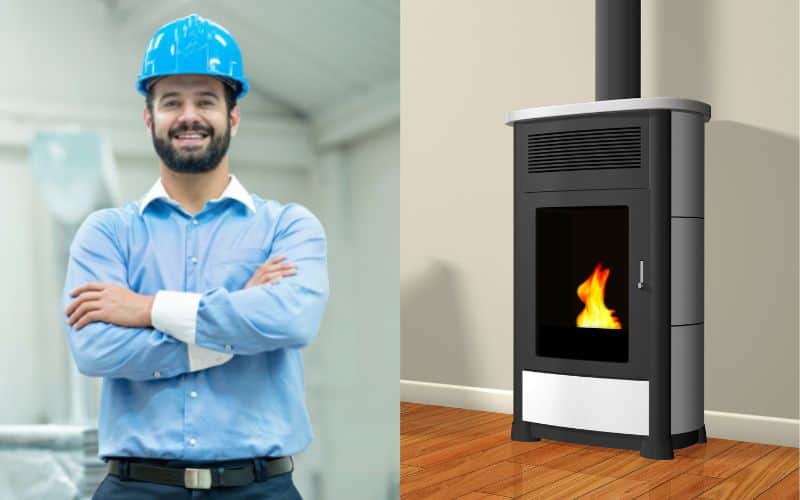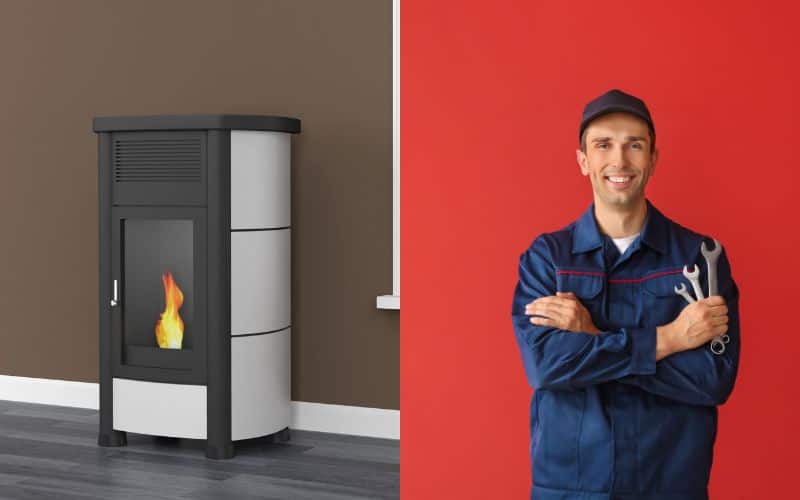The 10 Pros and Cons of Corn Stoves (and Where To Buy)

A corn stove is a type of biomass stove that uses dried corn kernels as fuel.
These stoves are affordable and great alternatives to pellet stoves or wood stoves. But before you buy one, let’s consider the pros and cons.
Corn stoves are environmentally friendly, easy to install, and produce little to no smoke. However, corn stoves require more maintenance than a wood-burning stove and can be difficult to ignite.
In this article, I will explore five pros and cons of corn stoves.
I will briefly describe where you can buy a corn stove for yourself. By the end, you will better understand whether they are right for you.
The Pros of a Corn Stove
As the world has become more industrialized, the demand for corn has increased. The increased production of corn has led to the development of corn stoves, an alternative to traditional wood-burning stoves.
Here are a few reasons why you should buy a corn stove instead of a wood stove.
Corn Stoves Are Environmental Friendly Compared to Wood Stoves

Corn fuel has increased in popularity recently as people seek to find more eco-friendly ways to heat their homes.
While corn stoves produce carbon dioxide, some sources suggest that the emissions are much lower than those from traditional wood-burning stoves or natural gas furnaces.
Moreover, corn is a renewable resource that can be grown relatively easily and does not require the felling of trees or extraction of natural gas.
Corn burning stoves are a great way to reduce your carbon footprint, as they produce fewer emissions. They are also a very efficient heating method, producing up to 8 hours of heat with just one gallon of corn.
Corn Stoves Produce Less Waste
There are many benefits to using a corn stove, one of which is that it produces less waste than a wood stove.
Corn stoves work by burning corn kernels, which produce a small amount of ash. This ash can then be used as fertilizer, making it a much more sustainable option than wood stoves.
Corn Stoves Are Easy To Install

Corn stoves are relatively easy to install.
Choose the right location for your corn stove. It should be located near an electrical outlet in a room you plan to spend a lot of time in, as this will be where you’ll be spending the most time heating. It should also be in a well-ventilated area, away from flammable materials.
Measure the space. You should ensure that your corn stove is the correct size for the room you’re putting it in.
Assemble the corn stove. Follow the manufacturer’s instructions to install your stove correctly. If in any doubt, seek professional advice from a qualified installer.
Connect it to a flue pipe. The flue system will ensure that the smoke can safely escape your home.
Corn Stoves Produce Little to No Smoke
The reduced smoke makes corn stoves an excellent option for people looking for a way to heat their homes without harming the environment. The reduced smoke also means that home air quality will not be affected when you use a corn stove.
Corn stoves work by burning corn kernels that have been dried and treated. The kernels are burned in a chamber that is lined with heat-resistant material. As the stove burns the corn, heat is produced, which heats the room.
Electricity is used for the automatic ignition of the corn via a fuel heating rod and to power a fan that circulates air through the combustion chamber. This air circulates through the chamber and up the chimney.
The circulating air helps to generate a draft that causes the fire to burn hotter and more efficiently. Therefore, the hotter the fire burns, the less smoke it produces.
You Can Recycle Corn Stove Fuel

There are several ways to reuse and recycle corn stove fuel. One way is to use it as a compost material. This method is beneficial for people living in rural areas with a lot of garden waste.
Another way to recycle corn stove fuel is to use it as a biofuel. To use the kernels are fuel, you’ll need to convert them into ethanol or biodiesel. This process is called gasification.
The advantage of using corn stove fuel as a biofuel is that it is renewable. It is also cleaner burning than fossil fuels, such as coal and oil.
There are several other uses for corn stove fuel, such as in animal feed and as a soil amendment.
Cons of a Corn Stove Compared To An Oil or Wood Stove
While a corn stove may be better for the environment than traditional wood or oil-burning stoves, you should be aware of some potential drawbacks to using a corn stove before making the switch.
Corn Stoves Require More Maintenance

Corn stoves require more maintenance because the corn must be consistently ground down into a fine powder to be used as fuel.
If the corn is not ground down correctly, it will not burn correctly and produce a lot of smoke.
In addition, you’ll need to clean your corn stoves out regularly. To do so, first, you’ll have to remove the ashes from the corn, then sweep the stove clean.
Failure to do this will result in the stove not working correctly.
Corn Stoves Are Difficult To Ignite
While a corn stove can be an efficient and cost-effective way to heat your home, it can be difficult to ignite. The difficulty is that the corn kernels are very dense and have a low moisture content.
To successfully ignite a corn stove, you need to use a special igniter called a “corn pellet igniter,” unless your stove comes with automatic ignition. A corn pellet igniter is a device that uses a small amount of corn kernel to produce a large amount of heat.
First, the corn pellet igniter is placed in the firebox of the corn stove. Then the kernels are placed on the igniter, and the igniter is turned on to light the corn stove.
Corn Stoves Have Difficult Heat Output

Another significant drawback of corn stoves is their difficulty in providing enough heat output compared to other fuels, such as natural gas.
The insufficient heating is because corn has a lower BTU rating than other fuels, such as wood pellets or natural gas. As a result, corn stoves are unsuitable for large homes or heating homes in cold climates, which are better off burning wood or oil.
Additionally, corn stoves need a lot of fuel. The large fuel requirement can be a problem in areas where corn is not grown locally or where corn costs are high.
Corn Stoves Require Electricity
Corn stoves, as the name suggests, use corn for fuel. However, many people don’t realize that corn stoves require electricity to run.
The electricity keeps the burning process going and is used by fans that radiate heat into the room.
The electricity usage means that they are not truly “off the grid” and can still contribute to your carbon footprint.
They are also not usable during a power outage, so if the electricity goes off regularly in your area and you don’t have a backup battery, you might be better off burning wood.
If you want corn stoves, even if you don’t have a reliable electric connection, you’ll need to get a specialized stove that doesn’t use electricity to move the heat into the room.
Corn Stoves Have Price Fluctuations

Stove prices have been rising for the last few years as the cost of living has increased, and fuel costs have risen concomitantly.
The price of a corn stove has been no exception. Corn stoves have become increasingly popular as a primary or supplemental heat source due to their low cost and efficiency.
Since the price of corn stoves is determined by the price of corn, a commodity, the stove price can be volatile. This volatility means that the price you pay for your stove today might differ from the price you pay for the same stove next month.
Therefore, If you are considering purchasing a corn stove, it is important to be aware of these price fluctuations.
Where To Buy a Corn Stove
When looking for a corn stove, you need to make sure that you find one that is right for your needs.
For example, you might want a freestanding stove, or maybe you have a large home and need a bigger stove that is the right size for your home.
There are many places where you can buy a corn stove.
You can purchase one from a retailer that sells fireplaces and stoves. Ensure that you’re buying a corn stove and not a pellet-only stove. You can also consider a multi-fuel stove.
You can find a list of American corn stove manufacturers at Wise Heat with ratings.
Conclusion
Corn stoves are eco-friendly, easy to install, and burn cleanly with little smoke.
These are significant advantages if you want to heat your home without a significant carbon footprint.
However, these stoves have some disadvantages, like the effort required to maintain them and the fact that most corn stoves, unlike wood-burning stoves, need electricity to run.
Despite these cons, corn stoves are a good option for those looking for an alternative to traditional wood or pellet stoves.
If you’re considering a corn stove for your new build project, you might also be interested in our article about sustainable building materials here.







